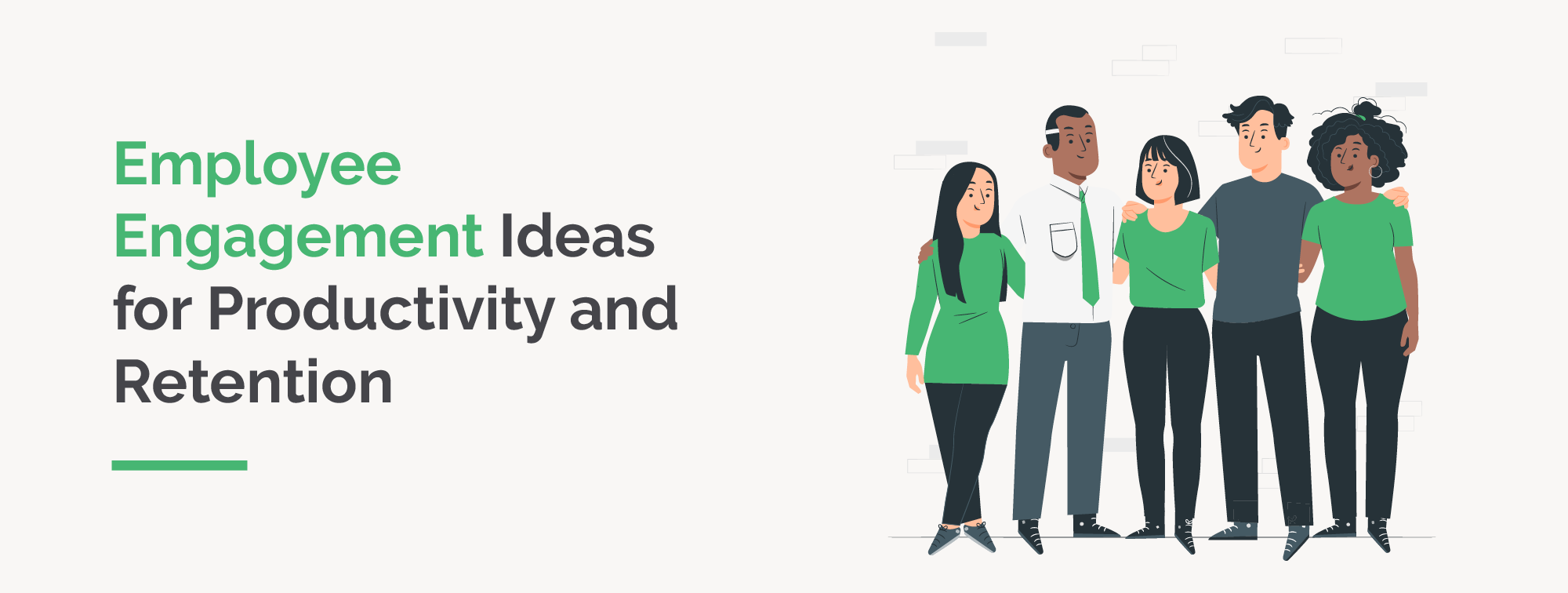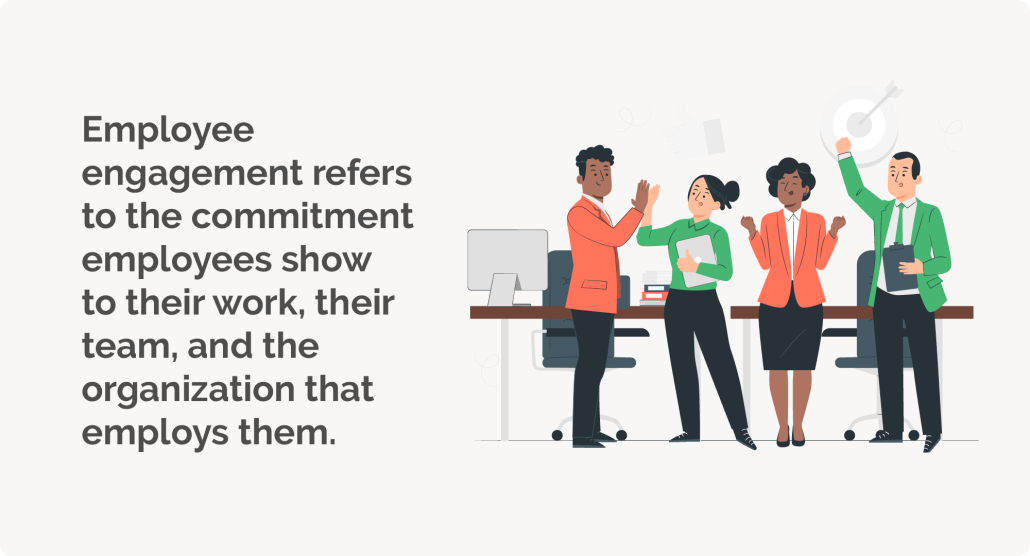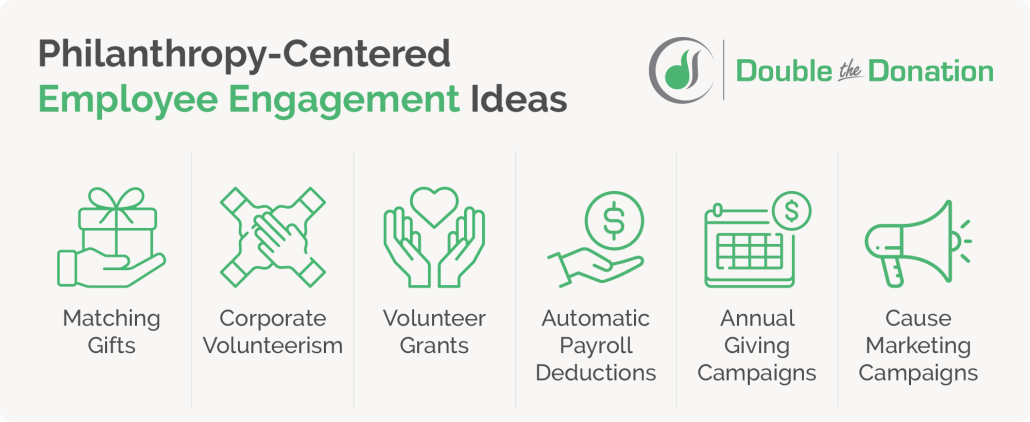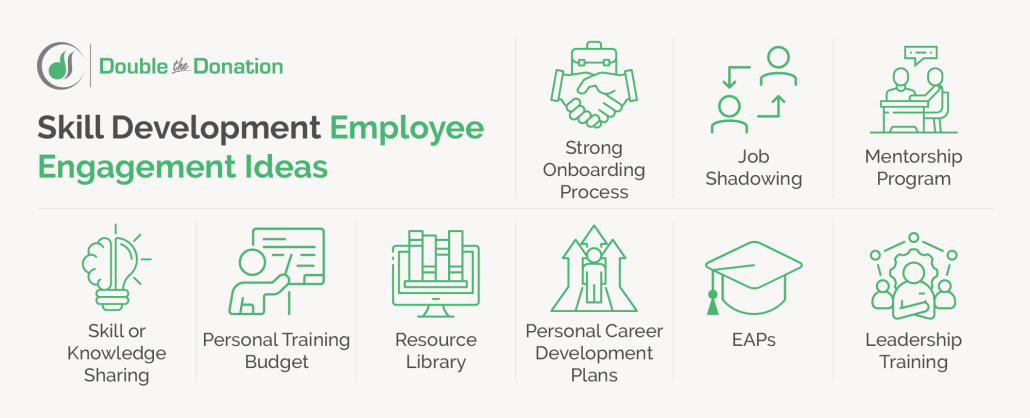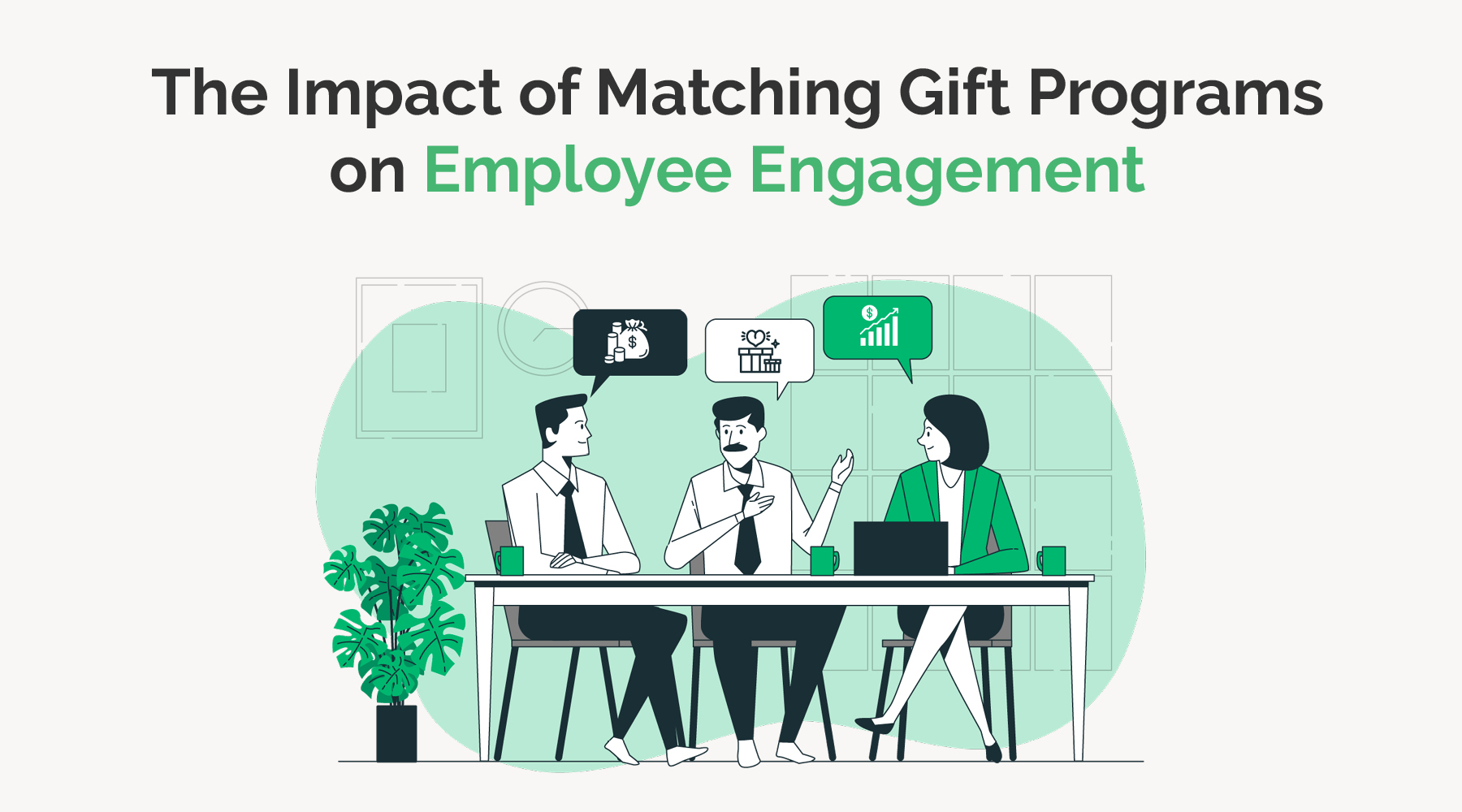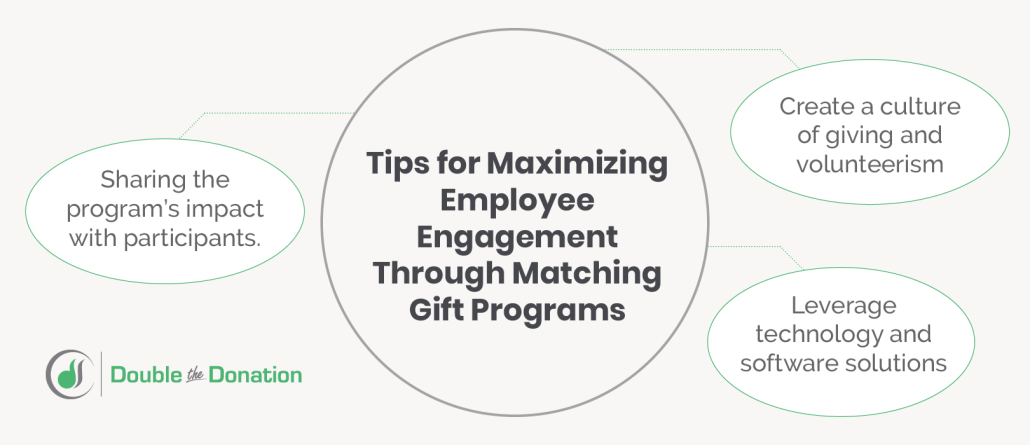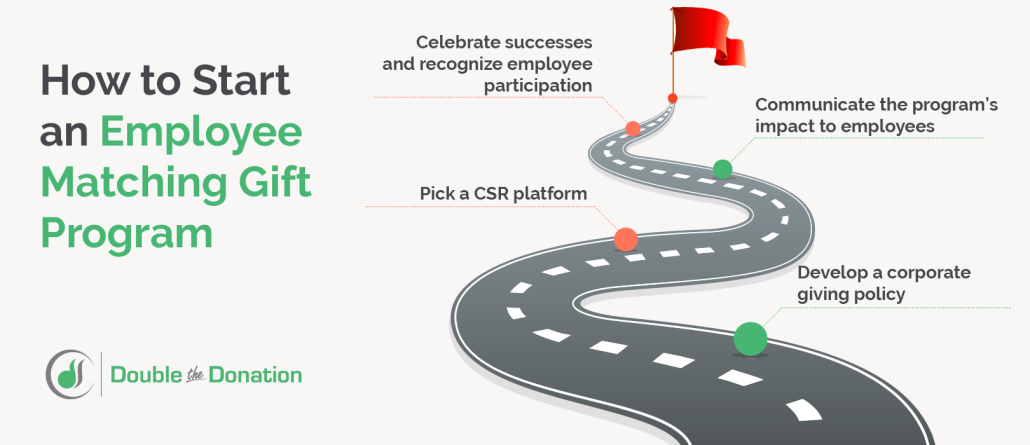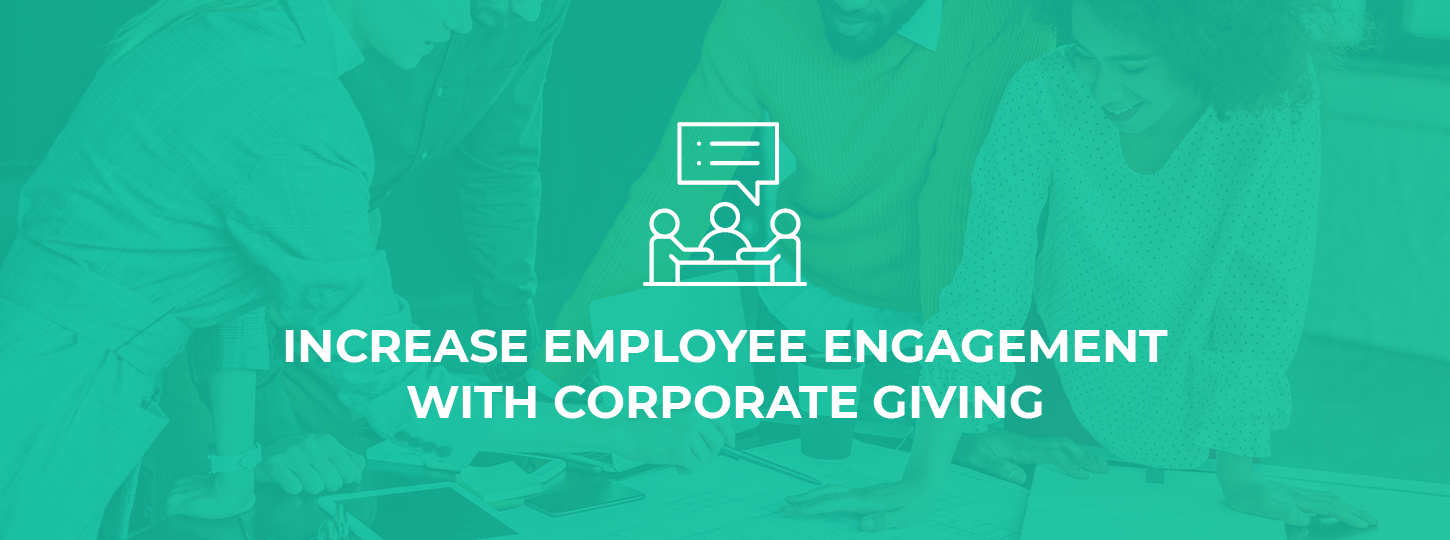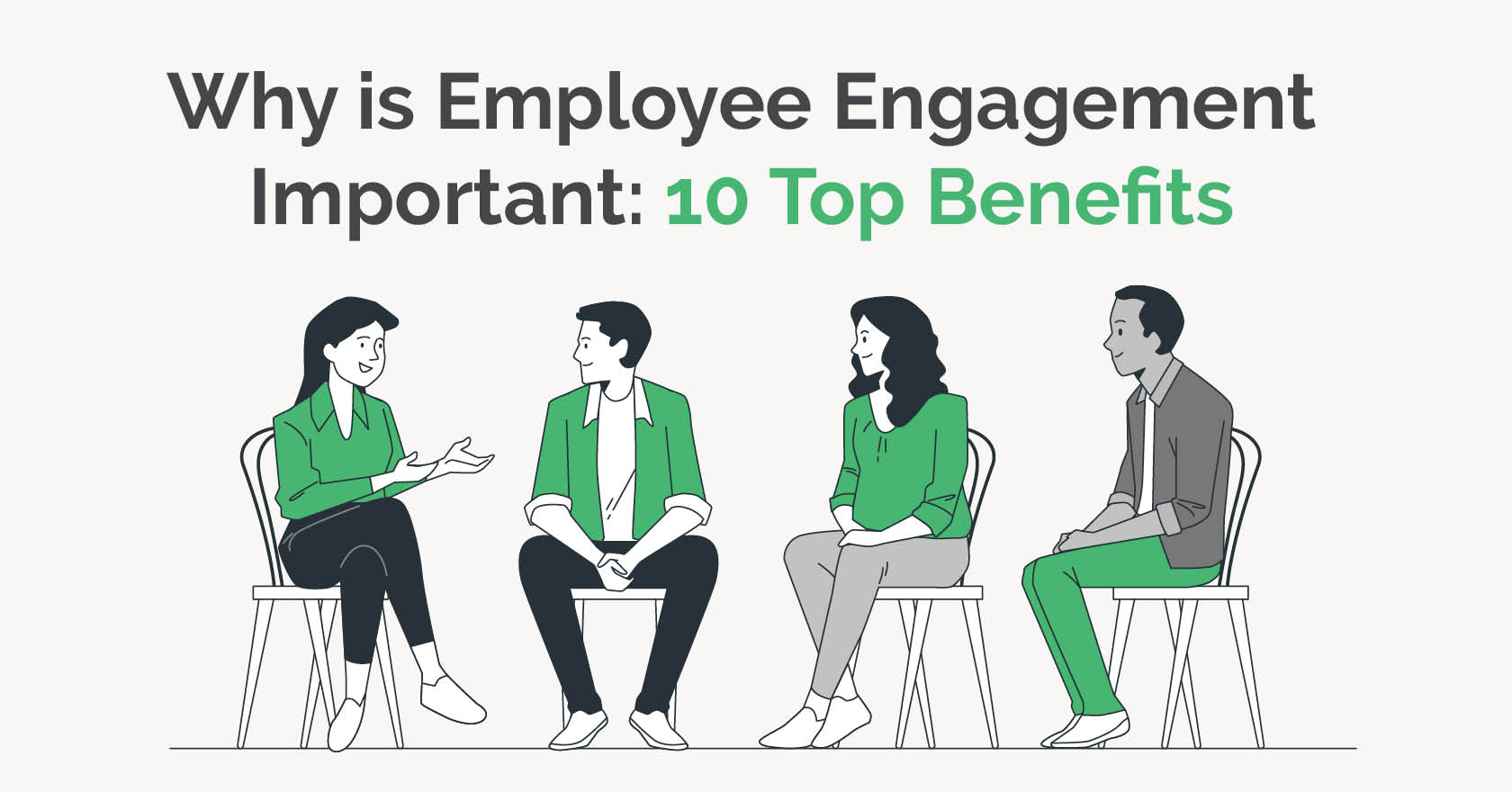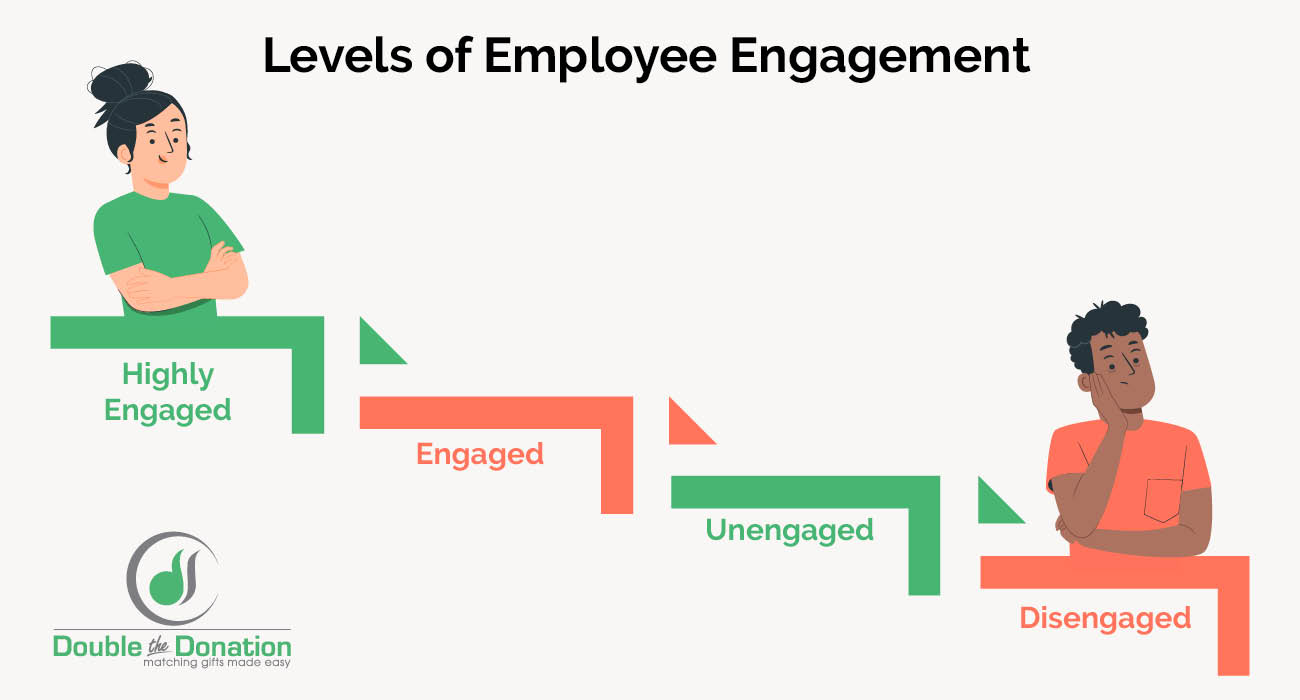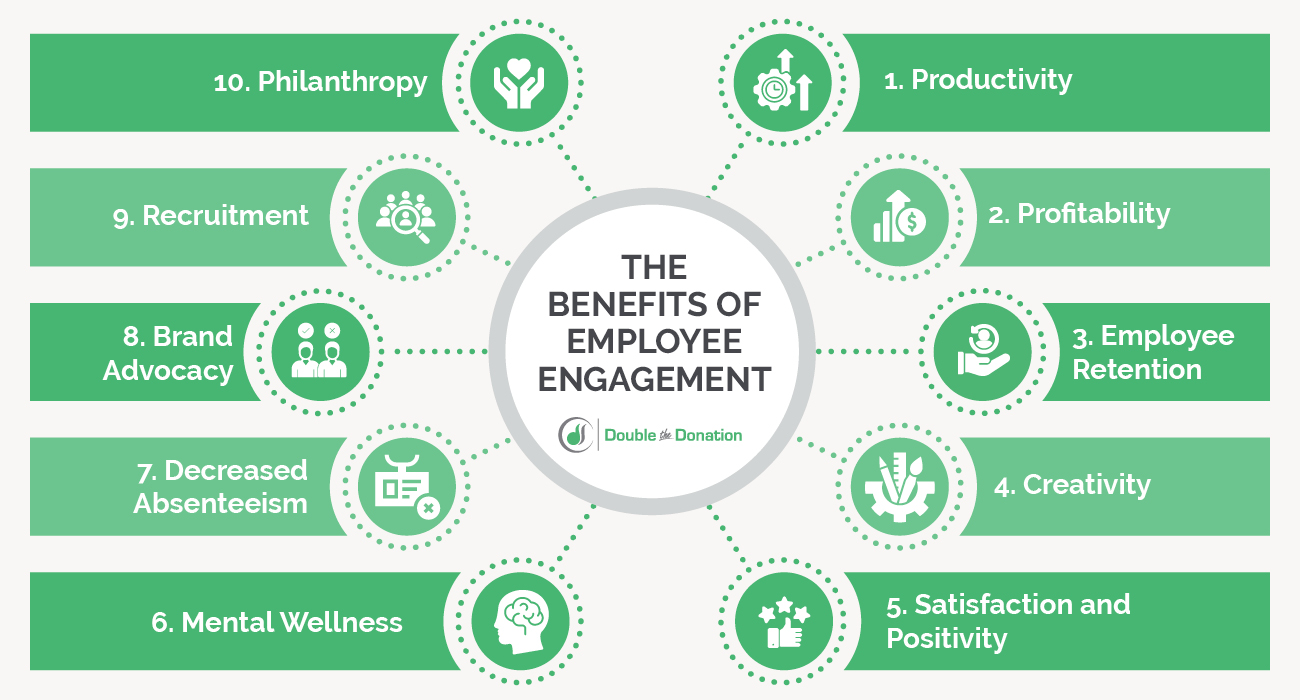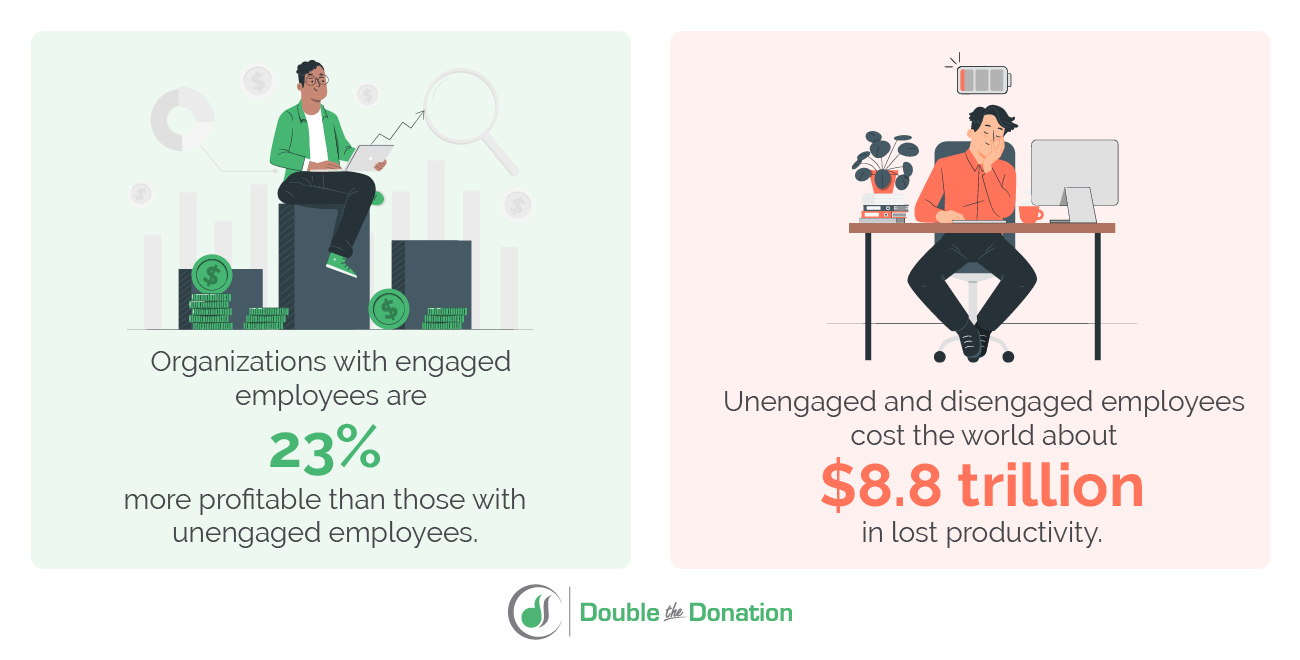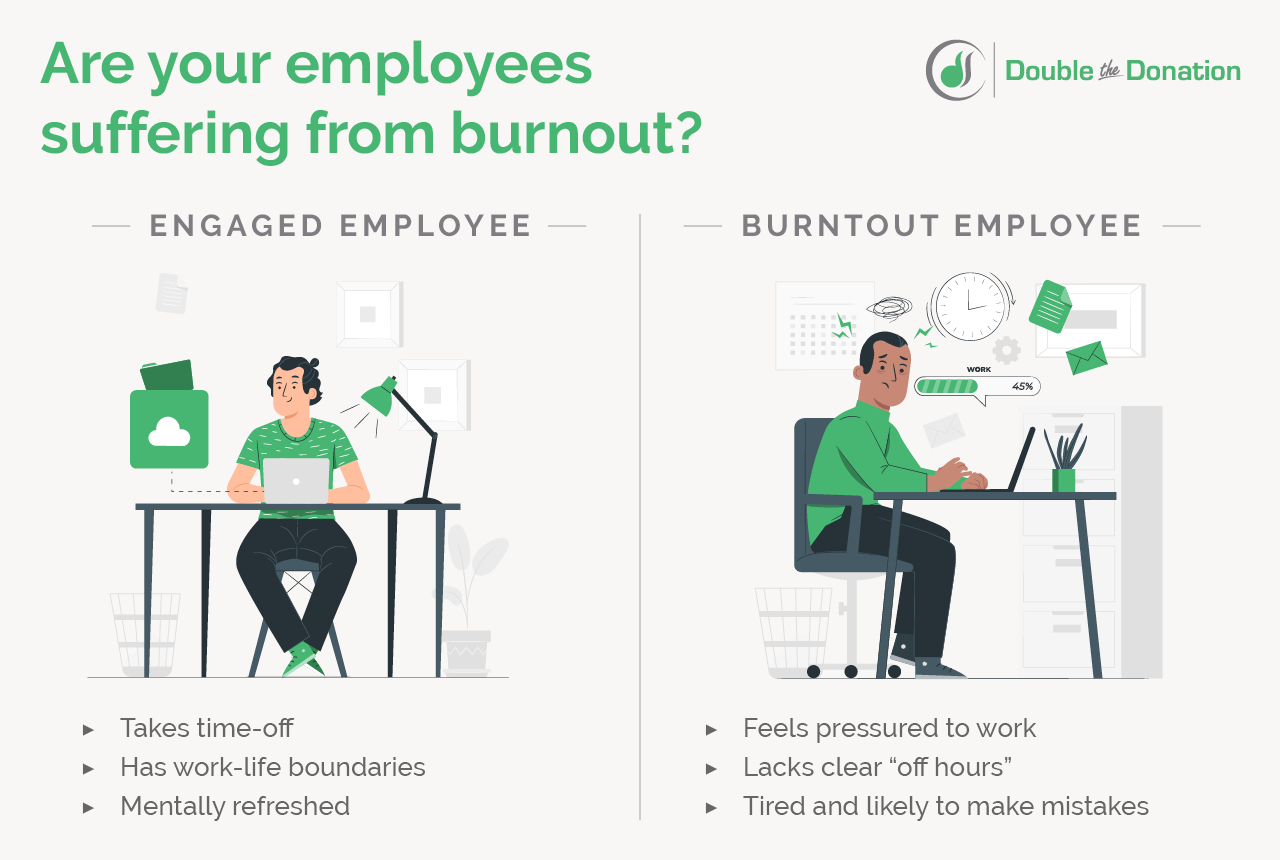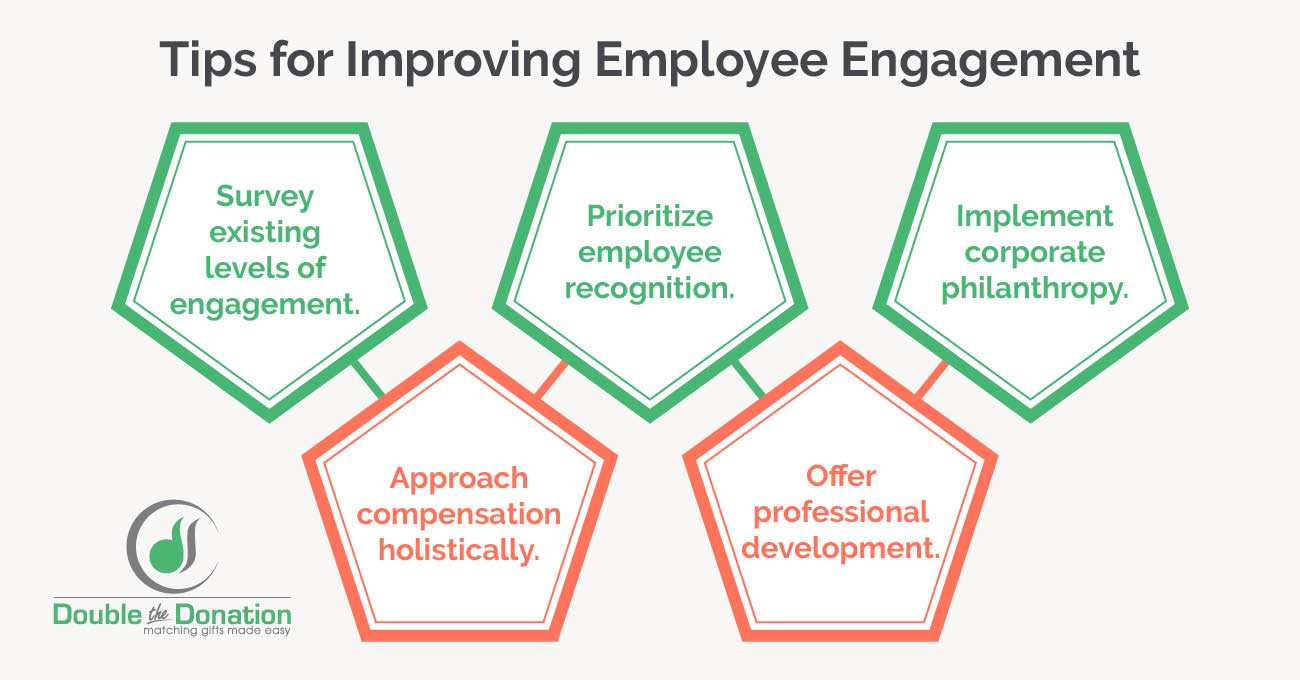52+ Employee Engagement Ideas for Productivity and Retention
Picture two imaginary employees who are both employed by the same company.
Employee A is an enthusiastic, hard worker who loves driving results in their role. They make an effort to contribute in meetings, bring creative ideas to the table, encourage their coworkers, attend company events, and more.
Employee B is also a hard worker and typically performs at a high level, but they seem to have lost some of their enthusiasm for their role. Over time, they’ve become less invested in the company’s goals and stopped actively participating in its internal culture.
The difference between Employee A and Employee B is that Employee A is fully engaged at work. This means Employee A is finding personal fulfillment and happiness in their job and feels good about what their company does and how it contributes to its community.
(Note: This doesn’t mean that Employee B is a “bad” worker by any means, just that their work experience could be improved, leading to better results for both them and the company.)
So, if Employee B was your employee, how could you encourage them to be more engaged at work? Or, thinking more broadly, how can your company hone its approach to employee engagement?
Here’s your answer: By tapping into the right employee engagement ideas!
There are dozens of ways to promote employee engagement in your workplace, all of which can help you take your productivity, profitability, and retention efforts to the next level. It’s a lot to sort through, which is why we’ve created this guide to help you explore your options. Here’s what we’ll cover:
- Employee Engagement: A Quick Overview
- Our Favorite Philanthropy-Centered Employee Engagement Ideas
- Other Top Employee Engagement Ideas
As you learn more about employee engagement and the many ideas and programs you can launch to improve it at your company, remember to take into consideration your company’s specific needs and culture. This way, you’ll implement the engagement initiatives that will most resonate with your current and future employees and drive real results for your organization. Let’s begin!
Employee Engagement: A Quick Overview
Before we get into the specifics of effective employee engagement ideas your company can try, let’s go over some fundamentals.
What is employee engagement?
Employee engagement refers to the commitment employees show to their work, their team, and their employer. In practice, employee engagement looks a little different at every organization, depending on your company culture and the unique personalities on your team. In general, you can expect that an engaged employee will be:
- Passionate and enthusiastic about their day-to-day tasks and how they contribute to the organization’s overall success
- Loyal to the company
- Consistently taking on additional responsibilities and strengthening their skills
- Productive and delivering high-quality work
- Adept at communicating
- Resilient in the face of changes and challenges
Note that when an employee is fully engaged in their work, they are not sacrificing their mental, emotional, or physical health or their personal lives for your company. Engaged employees take a healthy approach to work-life balance and set clear boundaries so they can give their best efforts while at work.
Why is employee engagement so important?
Employee engagement is important for companies to pay attention to, as it can affect all facets of your business operations, not just individual employees’ experiences working for your company. Specifically, high levels of employee engagement can help your company in the following areas:
- Retention. When your team members are satisfied with their jobs and feel loyal to your organization, you’ll be able to retain them for longer periods of time, saving your company time and money. Plus, when you need to recruit new employees, you’ll be better prepared to welcome them into a positive and productive culture backed by strong engagement strategies.
- Productivity. As your organization takes steps to proactively engage its team members, you’ll find that your employees will be more committed to your company’s goals, enthusiastic about their roles, and more focused on not just their day-to-day responsibilities but also how they can drive the most value for your company. As a result, engaged employees will be more likely to go above and beyond and do their best work, resulting in higher productivity levels, better deliverables, and more efficiency.
- Profitability. When your company isn’t worried about hemorrhaging talent and everyone feels empowered to do their best work, you’ll see higher revenue and decreased expenses all around. Plus, you’ll have the time and talent available to pursue new initiatives and offerings.
Any organization that employs people has a responsibility to its employees (and even its stakeholders) to ensure that it’s providing the best employment experience possible, as boosted retention, productivity, and profitability are wins for everyone involved.
The Current State of Employee Engagement
In recent years, employee engagement has been trending downward, according to Gallup. Engagement levels were at 36% in 2020 but dipped to 34% in 2021 and then 32% in 2022. Gallup notes employees’ reports of the following engagement elements declined during this period:
- Clarity of expectations
- Connection to the mission/purpose of the company
- Opportunities to learn and grow
- Opportunities to do what employees do best
- Feeling cared about at work
Following the COVID-19 pandemic, employee expectations have shifted. For instance, Forbes reports that employees now expect more trust, more flexibility, and more work-life balance. And if the Great Resignation of 2021 and 2022 is any indication, employees are willing to leave their current employers to have these expectations fulfilled at other organizations.
In order to see some positive trends in employee engagement numbers, employers everywhere have to be willing to be open-minded and communicative, and those efforts will include implementing winning employee engagement initiatives.
The Special Role of Corporate Philanthropy in Employee Engagement Initiatives
One of the best ways to effectively engage your employees is to involve them in your organization’s corporate philanthropy efforts. Because corporate philanthropy is how your organization gives back to its community and works to leave a positive impact on the world, it can benefit your employees by:
- Giving them a heightened sense of purpose. Though your company’s goals and mission likely already inspire your employees, furthering a charitable cause will give them a stronger sense of purpose in their day-to-day duties. Plus, they’ll feel good about what your company is doing to make a positive difference for others, strengthening their relationship with your organization as an employer.
- Connecting with their personal values. Many of your employees likely have an affinity for a charitable cause, whether it’s animal welfare or protecting the environment. By showing them your organization also cares about charitable causes and can empower them to give to causes they support, you’ll connect with their personal values and interests, further strengthening your relationship with them.
- Empowering them to connect with others. Many companies facilitate volunteer opportunities for their employees as part of their corporate philanthropy and employee engagement work. Volunteering allows employees to get to know their coworkers in different ways as they work together and provides them the chance to meet other people who are connected to your nonprofit partners.
- Giving them the chance to develop new skills. Similarly, volunteering can help your employees strengthen their existing skills or develop entirely new skill sets. For example, a graphic designer may find they have a knack for helping plan nonprofit events, or a customer service representative may find they enjoy tutoring young children in reading.
- Improving their health and wellbeing. According to the Cleveland Clinic, charitable giving can lower your blood pressure, reduce stress hormones, boost self-esteem, combat depression, and even help increase your lifespan.
If you’re looking for a way to help your employees make a positive difference in the world while simultaneously increasing their job satisfaction, involving them in corporate philanthropy is the answer!
Our Favorite Philanthropy-Centered Employee Engagement Ideas
In the spirit of getting your employees involved in your philanthropic efforts, let’s kick off our exploration of employee engagement ideas by exploring some of our favorite philanthropy-centered initiatives!
1. Matching Gift Programs
71% of employees think it’s important to work for companies that give back through philanthropy, making corporate giving a pivotal engagement tactic. One of the easiest and most impactful ways to involve your employees in corporate philanthropy is to start a matching gift program.
Corporate matching gift programs are a type of philanthropy in which companies financially match donations their employees make to nonprofits. Many companies match at a 1:1 ratio (dollar for dollar), but these ratios range anywhere from .5:1 to 3:1. That means employees have the opportunity to increase the impact of their charitable donations!
Why are matching gift programs a great employee engagement idea?
Matching gift programs are essential for employee engagement because they communicate that your company cares about the same causes your employees do. These programs amplify the charitable contributions of employees, making them feel their donations have a greater impact, which enhances their connection to your company.
Launching a matching gift program impacts your company in a few ways. For example, you can:
- Enhance workplace culture by giving employees a stronger sense of purpose through philanthropic giving.
- Demonstrate your company’s values to the public by aligning corporate objectives with employee interests.
- Attract talented employees who prioritize social responsibility, further enriching your company’s culture.
While most matching gift companies organize unrestricted programs (where the employer matches donations to almost any nonprofit), a “one-off” match initiative is a great way to ease into this engagement opportunity. In this case, your company would select one nonprofit to which you’d match donations, thus rallying your staff around a particular cause!
Although matching gifts are common workplace giving programs, many employees don’t know their companies even offer a program. That’s why your company should take the initiative to promote these programs. Whether that’s through onboarding or regular communications, alerting employees that they can double their donations to their favorite charities can inspire participation.
*While Double the Donation’s tool, 360MatchPro, offers custom matching gift program management functionality, this feature is designed specifically for fundraisers looking to manage custom matching gift initiatives. 360MatchPro does not work directly with corporations. If you’re a company interested in creating a matching gift program, contact us, and we’ll share information about our corporate vendor partners.
2. Corporate Volunteerism
Just as matching gifts are one of the most common types of corporate philanthropy programs out there, another common corporate philanthropy initiative is corporate volunteerism.
Through corporate volunteerism, companies encourage their employees to volunteer their time with local nonprofits.
Companies incentivize volunteerism in a number of ways, one of which is through offering paid time off during the year to volunteer (also known as volunteer time off or VTO). This is an extra incentive for employees because they get to support a charitable cause while still getting paid.
Many companies also offer volunteer days, such as a day of service, to promote team-building and give back to the community. This opportunity encourages coworkers to get to know one another and work as a team to help an organization.
Corporate volunteerism also benefits nonprofits because of the skills corporate employees bring to the table—which are often skills and expertise that the nonprofits may not otherwise be able to afford. Plus, employees may pick up new skills from their time volunteering with a nonprofit!
Why is corporate volunteerism a great employee engagement idea?
Companies that promote volunteer opportunities and actively encourage their employees to participate show that they care about giving back to the community, and some are even willing to offer paid time off to do so, demonstrating that they see volunteering as a priority. This initiative reflects well on companies and even encourages consumers to continue purchasing products and services from them.
When employees see the good their companies are doing in their communities, they are more likely to participate, think positively about their roles in the company, and be happier as a result.
3. Volunteer Grants
Corporate volunteerism doesn’t end with the time and effort that your employees offer nonprofits. There’s another type of workplace giving program directly related to volunteerism that can benefit nonprofits, reflect well on your company, and boost employee engagement.
Corporate volunteer grants turn volunteer hours into revenue for nonprofits. When employees at a company devote a specific number of hours to volunteering with a nonprofit, participating companies provide a set dollar amount for those hours to the nonprofit.
For example, this could look like:
- $25 for every hour an employee volunteers
- $15 per hour an employee volunteers, with a minimum of 20 hours
- $500 after volunteering 20 hours with a nonprofit
Corporate volunteer grants essentially help nonprofits meet their fundraising and volunteer needs at the same time. Meanwhile, your employees can increase their impact on causes they care about.
Why are volunteer grants a great employee engagement idea?
Nearly 3 out of every 4 employees say it’s important to work where company culture supports volunteering. The more you encourage volunteerism and promote volunteer grant opportunities, the more employees will feel engaged with your company and its values. Plus, volunteer grants are a great way for an employee to secure a donation for a nonprofit they care about without spending a dime.
Here’s a rundown of how this type of program can transform your workplace:
- Communicate your commitment to community involvement and social responsibility by financially supporting employees’ volunteer efforts.
- Underscore the importance of giving back, enhancing employees’ sense of purpose and connection to the workplace.
- Foster a positive work environment and strengthen team bonds through shared experiences in community service.
- Improve your company’s image and resonate with employees’ desires to work for organizations that reflect their values.
Ultimately, volunteer grant programs not only contribute to societal well-being but also promote a more engaged, motivated, and satisfied workforce. Like with matching gifts, volunteers are often unaware that their employer even offers a volunteer grant program. That’s why it’s essential to actively promote these opportunities to employees and streamline facilitation with dedicated CSR software.
4. Employee Wellness Programs
Wellness programs are comprehensive initiatives designed to promote holistic health and well-being among your workforce. These programs encompass a wide range of activities and resources aimed at supporting physical, mental, emotional, and sometimes financial health.
Key components often include fitness challenges, mental health support, nutritional advice, and stress management workshops. While these programs can take many forms, the overarching goal is to create a healthier, more productive workplace by reducing health-related absences and enhancing job satisfaction.
Why are employee wellness programs a great employee engagement idea?
In essence, prioritizing employees’ health and happiness will contribute to a supportive work environment that reduces turnover. Better yet, you can leverage an app to run your entire program.
Designed to streamline program administration and boost employee participation, Givhero can significantly enhance your wellness program by integrating workplace giving into health and wellness challenges. This unique approach motivates employees to engage in healthy behaviors by linking their actions to a broader social impact.
Here’s an overview of how the app works:
- Create challenges. Your team chooses from Givhero’s library of health and wellness challenges, whether you want to challenge people to walk 10,000 steps a day or sleep 8 hours each night.
- Employees join the challenge. They’ll need to download the Givhero app and choose a nonprofit to support from Givehero’s Partner Network of over 2.3 million charitable causes.
- Employees participate in the challenge you choose. As they achieve their goals, they’ll be rewarded with donations to their chosen charity.
It’s that simple! Employees can engage in activities that boost their mental and physical health while supporting causes they care about.
Overall, Givhero serves as a powerful tool for companies looking to deepen employee engagement through wellness initiatives that also support social responsibility goals.
5. Automatic Payroll Deductions
Another form of workplace giving that can lead to high employee engagement is automatic payroll deductions.
An automatic payroll deduction allows employees to set aside a small portion of each paycheck to donate to a charity.
Automatic payroll deductions are great options for employees because they can give to nonprofits in smaller increments—especially if they’re unable to donate a large sum at once. If their employer also offers a matching gift program, those donations can even be doubled.
Companies typically vet charitable organizations beforehand to ensure their employees’ automatic payroll contributions are going to reputable nonprofits. This measure will reassure employees that their donations are going to a good cause.
Why are automatic payroll deductions a great employee engagement idea?
By making it easy for employees to give to reputable organizations, your company accomplishes a few things:
- Employees get to make a difference for the causes they care about.
- The donations have no extra fees for the nonprofits (like credit card processing fees) and are still tax deductible for employees.
- Employees will continue to participate in automatic payroll deductions long-term because of the ease and security associated with these programs.
The more options you offer as part of your workplace giving programs, the more likely employees will be to engage with and participate in those programs. Automatic payroll deductions are an excellent option to consider as a company.
6. Annual Giving Campaigns
The year-end giving season (generally October through December) is the most popular time for nonprofit donations. During this time, donation numbers are higher than all year round as people lean into the generosity they feel around the holidays and wrap up their charitable giving that will be deducted from their taxes in the spring.
Companies can use this time to encourage their employees to donate to important causes, either through monetary or time donations. When paired with matching gifts and corporate volunteer grants, the impact goes even further.
Many nonprofits run annual giving campaigns around this time of year to raise a large portion of the funds they need to continue serving their missions, especially on GivingTuesday, the Tuesday after Thanksgiving in the U.S. Encouraging your employees to give during these campaigns is especially important for the nonprofits they support but also for your company’s image.
Why are annual giving campaigns a great employee engagement idea?
If your company wants to boost engagement among its employees, be sure to encourage them to participate in annual giving. Promote specific opportunities to donate to nonprofits whose missions align with your company values. This practice reflects well on your company in the public eye, while also showing your employees that giving to worthy causes is an important component of your business practices.
7. Cause Marketing Campaigns
As a big part of corporate philanthropy, companies will often launch a cause marketing campaign in conjunction with a nonprofit cause. During a cause marketing campaign, a company increases its own profitability while also doing good in the communities in which it operates.
Here are some examples of cause marketing:
- Businesses encourage customers to round up their purchases to donate to a specific charity or cause.
- Businesses donate a portion of their profits to a specific charity or cause.
- Businesses accept donated goods to provide to specific charities.
Both the for-profit and nonprofit sides benefit from cause marketing. For-profit businesses can see an increase in sales and exposure, while nonprofits receive more funding and goods that help them serve their constituents.
Why are cause marketing campaigns a great employee engagement idea?
Cause marketing is a great employee engagement idea because it actively encourages employee participation in promoting a nonprofit’s cause to the customers or clients they interact with. Remember that cause marketing works best if your company is helping a cause that your employees believe in. If your staff supports the idea, they’ll work harder and be more invested in helping drive results for both you and your nonprofit partner!
The Key to Making These Engagement Ideas Work: Corporate Giving Software
For all of these philanthropy-centered employee engagement ideas, you’ll want to have an organized system in place to facilitate your initiatives. With so many moving parts and workplace giving options, it can be challenging to consolidate donations, volunteer opportunities and hours, and matching gift requests in one place.
Corporate giving software is a must when it comes to organizing your workplace giving programs.
Using a corporate giving platform, you can:
- Track and review employee donations, including automatic payroll deductions.
- View and approve employee matching gift requests.
- Allow employees to log their volunteer hours.
- View and approve volunteer grant requests.
- Post and coordinate volunteer opportunities for your employees.
- Organize team volunteer events.
These are just some of the ways corporate giving software can help keep your company on track.
A Must-Have Feature in Corporate Giving Software: Matching Gift Auto-Submission
The best corporate giving software will offer matching gift auto-submission that allows you to streamline the matching gift process for your employees and ensure that your matched donations get to nonprofits quickly.
Check out how our auto-submission feature works by watching the video below:
Be sure to invest in the right software that will allow your company to benefit the most from the workplace giving programs you’ve already put so much effort into, and make sure your platform offers auto-submission capabilities.
Examples of These Employee Engagement Initiatives in Action
As you build out your own corporate philanthropy-centered engagement program, it will be helpful to get inspired by other companies’ programs so that you can ensure yours is poised to be as effective as possible. Here are two examples of companies that are doing good in their communities and getting their employees involved in their efforts!
Google: Matching Gifts
Google offers a matching gift program that its full-time and part-time employees, as well as its board members, are eligible for. It matches gifts up to $10,000 per year per employee at a 1:1 ratio.
In addition, Google also offers donation matching for any funds contributed for disaster or international relief and matches funds that employees personally raise for charitable events (such as walk-a-thons).
Walmart: Volunteer Grants
Walmart offers a volunteer grants program called Volunteerism Always Pays (VAP) that individuals or groups can participate in.
For the individual VAP grants initiative, Walmart gives $10 per hour to the nonprofit an employee volunteers with, up to $1,000.
For the group VAP grants initiative, Walmart offers groups that volunteer together or participate in fundraising runs or walks together grants for $500-$5,000 dollars, depending on the number of employees in the group.
Remember, your company’s own program will likely look a little different than any example you’re inspired by because you have your own values, priorities, and budget to keep in mind. Still, it’s handy to get an idea of what these programs look like at successful companies!
Want to dive into more examples of real-world corporate philanthropy-centered engagement programs?
Other Top Employee Engagement Ideas
Although corporate philanthropy initiatives are an excellent way to engage your employees, there are lots of other employee engagement ideas you can tap into, as well. Let’s explore some other options, all of which we’ve sorted into a few different categories:
- Recognition and Rewards Ideas
- Team-Building Ideas
- Skill Development Ideas
- Health and Wellbeing Ideas
- Work-Life Balance Ideas
- Communication and Feedback Ideas
You may decide to choose one or even several ideas from this list. Whatever you choose, remember to customize these ideas to fit your specific employees’ needs and expectations!
Employee Engagement Ideas for Recognition and Awards
Many employers make the mistake of assuming their gratitude for their employees is simply implied. However, the truth is that employees need consistent and genuine recognition to feel motivated and encouraged to perform to the best of their abilities.
In fact, according to Nectar HR, nearly 84% feel that recognition impacts their motivation to succeed in their jobs. In this section, we’ll look closely at some employee engagement ideas that involve recognition and awards.
1. eCards
Your employees’ contributions are valuable and deserve more recognition than an occasional pat on the back. Fold recognition into your everyday routine with custom eCards.
eCards are greeting cards’ virtual counterparts, making them easy to send and even easier to create. Plus, when you work with the right eCard site, you can customize your eCards to reflect your organization’s branding or the achievement you’re calling an employee out for reaching. Take this eCard for example:
Digital greeting cards have emerged as a versatile tool for employee recognition, enabling managers and employees alike to show appreciation for their coworkers. They offer several benefits to companies, like:
- Immediate Recognition: Managers and peers can quickly acknowledge achievements, milestones, or contributions without the delays associated with traditional recognition methods. This ensures that recognition is timely, reinforcing positive behaviors and accomplishments as they happen.
- Personalization: eCards can be customized to reflect the recipient’s personality, the specific achievement, or the company’s culture, adding a personal touch to the gesture. Send a personal message with each eCard to enhance the emotional impact of the recognition and make employees feel genuinely appreciated.
- Accessibility and Convenience: Given the digital nature of eCards, they can be sent and received from anywhere, at any time. That makes it easy to fold recognition into everyday work routines, whether you’re working in person or remotely.
- Cost-Effectiveness: Compared to traditional recognition gifts, eCards don’t require physical materials or postage to send. That means you can cut down on costs.
If you’re more of a visual learner, check out this video that highlights our recommended eCard software, eCardWidget:
2. Incentive Bonuses
Depending on the nature of your organization, giving an incentive bonus might be a natural extension of your employees’ work. For example, if your organization is a store that sells musical instruments, you might offer a commission system that incentivizes salespeople to work toward ambitious sales goals.
In other contexts, you may have to get creative with how you offer incentive bonuses. One popular way is to offer an annual holiday bonus, given at the end of the calendar year before the winter holidays, or as a retention award during performance reviews.
However you decide to offer bonuses, make sure you’re clear with your employees about who is eligible to receive a bonus, how much the bonus is worth, and how and when that bonus is paid out.
3. Employee of the Month Program
An employee of the month program is a popular way to thank your top performers for all of their hard work and show them just how much your organization benefits from their efforts. To set up a fair and sustainable program, follow these steps:
- Define the criteria for becoming Employee of the Month.
- Create a nomination process that managers or peers can use to nominate employees for the award.
- Form a committee to choose the winner of the award.
- Select rewards the Employee of the Month will receive, such as bonuses, gift cards, special parking privileges, etc.
- Promote the program to your employees.
The key to a successful employee of the month program is consistency. Be consistent in how you administer the program and in how you incorporate it into your internal culture. If your employees are excited about the program, it will be a great motivator for solid performance!
4. Pass a Post-It
This recognition idea is a simple one but goes a long way. Simply hand out some Post-its and pens to your employees, and encourage them to write words of encouragement or kind messages to their coworkers, sticking the Post-its on their desks or cubicle walls.
This is a quick and easy way to foster a spirit of appreciation within your organization and to get employees involved in recognizing each others’ contributions.
5. Workaversary Celebrations
Work anniversaries (also known as “workaversaries”) are exciting professional milestones and represent an employee’s loyalty and dedication to your organization. Consider celebrating individuals’ workaversaries in small and meaningful ways. For example, you might post about an employee’s achievements in the last year on LinkedIn, or write them a thoughtful card.
You can also celebrate large lengths of tenure, like a 5-year or 10-year anniversary at your organization. Consider making these celebrations a bit bigger, like a catered lunch or an after-hours work party. This can be an excellent way to demonstrate to all of your employees just how important retention is to your organization and its goals.
6. Personal Milestone Celebrations
In addition to workaversaries, there are plenty of personal milestones that your employees might experience, including:
- Getting married
- Buying a house
- Having a baby
- Adopting a new pet
- Educational achievements
Show your employees that you care about their personal achievements by celebrating these memorable milestones. For instance, if an employee adopts a dog, you might gift them a bag of dog treats. Or, if they have a baby, you might send them a custom baby blanket featuring their child’s name.
Team-Building Employee Engagement Ideas
For your employees to enjoy their work experience at your organization, they need to feel connected to the people they’re working with. It’s great if your organization can facilitate healthy working relationships between coworkers, but employees will also benefit from building genuine friendships. In fact, Gallup has found that employees who have a best friend at work are more likely to get more done in less time, innovate and share ideas, and have fun while working. These team-building ideas can help you create an environment where strong relationships can grow between team members.
1. Group Activities or Outings
Try hosting activities during or outside of work hours that allow your team members to get to know each other. These might include:
- Sporting events
- Museum, art gallery, or theater outings
- Cooking classes
- Art or craft workshops
- Picnics, barbecues, or potlucks
To engage your employees in these activities even more, hand the brainstorming and planning over to them. Create an “extracurriculars” budget (i.e., $20-$30 per participant) and allow employees to plan company- or team-wide outings of their choice once per quarter or once per year. This way, you’ll get many activities on the calendar quickly as well as a variety of different activities for employees to choose from to attend.
2. Team-Building Exercises
Team-building exercises are fun activities that groups of employees participate in to strengthen their collaboration and communication skills and to build trust with each other. You’re likely familiar with some popular team building exercises, like The Human Knot or trust falls.
However, there are a number of other exercises to consider, such as playing Two Truths and a Lie, working through an escape room together, completing a ropes course, creating a collaborative art piece, or playing the Blind Obstacle course game, where everyone helps blindfolded team members navigate obstacles and make it to the finish line.
Each of these exercises encourages your employees to unite, talk to each other, and work through problems and challenges together, strengthening their connections to one another.
3. Company Retreat
A company retreat is more of a large-scale employee engagement idea that will require some planning. A retreat gives you the opportunity to get your team together all in one place to enjoy work- and non-work-related activities alike. The best thing about a company retreat is that it sets aside some time for all of your team members to focus on their work relationships and create a collective memory together.
You don’t even have to go far to have a successful company retreat—even a day-long retreat at a local park or events center can give you plenty of time to ensure all of your employees are forming strong connections with each other.
4. Office Competitions
An office competition allows you to tap into your employees’ competitive spirits and encourage them to work toward a common goal. Here’s how to set one up:
- Divide your employees into groups. For example, you might make each department its own team or create groups at random to encourage employees to interact with coworkers they don’t usually work with on a daily basis.
- Choose the type of competition. There are many different types of competitions you could run, from a desk decorating contest to a trivia contest. One of the most popular types of office competition is a fitness challenge, where team members work toward a goal related to fitness or exercise. For instance, you might challenge your employees to see which team can walk the most steps in a month.
- Select a reward. Motivate your employees to participate in the challenge by offering some sort of reward or prize to the winning team, like a trophy, an extra vacation day, or a catered lunch at the office.
Once you’ve set up your competition, you’ll need to get your employees on board. Don’t forget to continue encouraging participation and spreading enthusiasm for the competition even after it starts so they stay engaged for the duration of the competition.
5. Office-Wide One-Off Projects
No matter what your company does, whether you’re a consulting firm or a retailer (or something else entirely!), you and your employees are used to working together toward a common goal. But there are likely projects or initiatives you wish you could get to that are frequently put on the back burner for the sake of day-to-day priorities.
Why not put your team’s regular synergy to good use on a one-off project to try to accomplish something out of the ordinary? For instance, you could choose one project or initiative each quarter that team members will contribute to outside of their usual tasks.
Not only does a one-off project change things up for your team, but it also allows them to work more closely with team members they don’t usually collaborate with.
6. Team Member Spotlights
It’s important to consistently build a strong internal community at your company. However, this is especially tricky at large organizations, where team members might not always have the opportunity to interact with each other often or get to know new hires right away.
Help your employees get to know each other by creating and sending out team member spotlights. A spotlight should walk through some simple get-to-know-you information for each employee, like their name, background, hobbies or personal interests, and a fun fact about them. It will also be helpful to include their professional headshot and a link to their LinkedIn profile.
You can easily incorporate employee spotlights into company-wide meetings or emails.
7. Diversity, Equity, and Inclusion (DEI) Initiatives
How diverse is your team, and is your organization welcoming to all different types of people with a variety of backgrounds and experiences?
You can prioritize DEI in several ways, from adopting diverse hiring practices and establishing policies on gender- or race-based discrimination to conducting regular pay audits to ensure pay equity or making your office space more accessible for individuals with disabilities.
Each organization will have different DEI needs, so take into consideration where your own organization is starting from and how you can improve your efforts.
8. Employee Resource Groups (ERGs)
Many employees may benefit from joining an ERG, which are groups employees form over a shared characteristic, whether that is gender, lifestyle, ethnicity, or something else. For instance, employees at your organization might be interested in creating a working mothers ERG, or a group for veterans.
ERGs allow employees to come together and support each other in workplace. They may also advocate for the development of new policies related to their ERG’s needs, help each other develop professionally, or host social outings for individuals in the group to get to know each other better.
9. Sports and Recreation Clubs
Many of your employees may enjoy getting together to participate in a sports or recreation activity, whether it’s soccer or rock climbing. Encourage employees to start clubs that meet outside of work hours where they can pursue these interests.
These types of clubs also ensure employees stay active, which is especially important if their jobs require them to remain stationary or sit at a desk for most of the day.
10. Book and Film Clubs
Similarly, employees may enjoy getting together to discuss literature or film. These are also activities that can be held after work or during a lunch break.
The important thing with clubs is to make sure that you let your employees know that you fully support them in getting to know each other over shared interests. You can even go the extra mile by joining or creating a club yourself!
11. International Day Celebrations
International Days like International Women’s Day or Human Rights Day can be great opportunities to recognize and celebrate people within your organization. On international days you choose to recognize, send out an educational email, and incorporate some sort of related activity into your workday.
For instance, on International Women’s Day, you might start your morning meeting by highlighting a few women who have made a big impact on your field or industry.
In some cases, you might also celebrate important holidays from a variety of cultures. For instance, you might recognize both Hanukkah and Christmas in December by putting up a variety of holiday decor around your office.
12. Birthday Celebrations
It’s important to celebrate individuals, too. In addition to celebrating workaversaries or personal milestones, don’t forget that celebrating birthdays can be a great way to help individual employees feel valued and seen.
Keep these celebrations simple by providing the employee’s favorite treat during lunch and giving them a birthday card signed by their peers.
Skill Development Employee Engagement Ideas
Some employee engagement programs can simultaneously increase your employees’ job satisfaction and help them further develop their professional skill sets.
It’s critical for your company to offer opportunities like these because most employees want to learn and grow at their jobs. According to Zippia, 49% of employees say they would stay at a company longer if it invested in their learning and development, and 68% of employees say that training and development are the most important company policy.
Let’s look at some employee engagement ideas that will promote professional growth and skill development.
1. Strong Onboarding Process
You might be thinking, “Onboarding is already something we do. In fact, we have to do it every time we hire someone.”
That may be true, but that doesn’t mean you can’t think of onboarding as an opportunity to engage your employees, both old and new.
As you train new team members, involve long-time team members where you can. For instance, you might have current team members give presentations about their roles or departments to help orient the new team member.
This way, not only is the new team member learning from their manager, but they’re also getting the chance to interact with individuals from other areas of the company, growing their network and giving them a more expansive understanding of how the company works as a whole.
2. Job Shadowing
Job shadowing offers an opportunity for an employee to observe an employee in a different role and get an understanding of their responsibilities and daily tasks. This is a great way for a team member to explore different roles and consider their own options for their progression at your company.
For example, say an employee decides to shadow a manager on another team. They could observe the manager balancing their regular duties with management responsibilities, see how they communicate with their direct reports, and ask questions about why they decided to take a management path. With that information in their hands, the employee could then make informed decisions about the trajectory of their own career.
3. Mentorship Program
Try starting a mentorship program at your company, where senior team members mentor team members who are early on in their careers or new to your organization.
Through mentoring, your employees can learn new skills, get advice about their career paths, build friendships, and receive feedback on their performance. A mentoring relationship can also be a safe space for employees to voice ideas, concerns, and needs.
To identify team members who can serve as mentors in your program, look for individuals who:
- Have substantial experience at your organization and in their field
- Have the availability for regular meetings with their mentees
- Are effective communicators
- Are committed to your organization and its values
Though not every mentor needs to have management aspirations, it can be a great plus for those seeking management opportunities to be able to mentor other employees.
4. Skill or Knowledge Sharing
There’s likely a wealth of knowledge and skills in your company already. So, why not facilitate opportunities for employees to share their knowledge and skills?
Skill- or knowledge-sharing opportunities are presentations where an employee shares a skill they’ve learned in their role with the rest of your team. This is a great chance for employees to see what their coworkers’ roles are like and swap useful skills that make their work experience better.
For example, one employee might present their strategy for managing their email inbox. Another employee might discuss the sales process. No matter what your employees have to share, your entire team can learn something new.
These presentations are great to host as informal Lunch and Learn meetings.
5. Personal Training Budget
Every employee is different and will have unique professional development and training wants and needs. Empower your employees to pursue the professional development opportunities they’re most interested in by designating a personal training budget for each employee. For instance, you might cover $100 worth of training materials, conference registration fees, or online course costs for each employee each year.
As employees can choose which training opportunities they want to take advantage of, they’ll not only sharpen their skill sets but also learn skills that provide more value for your company. Don’t forget to encourage employees to share what they learn with the rest of your team.
6. Resource Library
Building and maintaining a resource library is an effective strategy for not only helping employees develop professionally but also preserving all the knowledge and skills that your team brings to the table.
Your resource library can include things like your employee handbook, online training courses, ebooks, podcasts, videos and webinars, training and safety manuals, and more.
To make sure your resource library is useful to your company, consistently direct your employees toward it when they have questions or when they express interest in professional development.
7. Personal Career Development Plans
Encourage your employees to work with their managers to develop a personal career development plan. These plans help employees visualize their professional futures and the steps they’ll need to take to achieve their long-term goals at your organization.
For instance, an employee may set a goal to become a manager, outlining the skills and attributes they’ll need to develop over a set amount of time to be eligible for a management position when the opportunity arises. Or, another employee may be interested in becoming a subject matter expert (SME) in a certain area, and, working with their manager, identify the online courses they need to take or conferences they need to attend to learn about a certain topic and become your organization’s go-to person for that subject.
8. Educational Assistance Programs (EAPs)
Some employers pay for employees’ education expenses through educational assistance programs. For instance, companies like McDonald’s and Walmart offer tuition assistance for eligible employees who want to pursue a college degree.
In addition to covering educational expenses like tuition, books, or online learning subscriptions, you can also provide flexible scheduling that allows employees to attend classes or study without sacrificing their work hours.
9. Leadership Training
Your employees may have aspirations to become managers or leaders themselves one day. Share your knowledge by hosting optional leadership training meetings consistently. You can cover topics like:
- Delegation
- Active listening
- Problem-solving
- Playing to your strengths
- Strategic thinking
- Influence and persuasion
You can also invite leaders from across the company to present on these and other topics. Make sure to provide plenty of personal experiences and anecdotes as you share how you’ve developed these skills over the years.
Health and Wellbeing Employee Engagement Ideas
Are your employees happy and healthy? Your employees’ physical, mental, and emotional health can all impact how they feel about their jobs and also affect other aspects of their lives (such as their relationships).
This next set of employee engagement ideas focuses on ways you can engage your team members through health and wellbeing initiatives and stresses the importance of the connection between employees feeling cared for at work and how engaged they are.
1. Stress Management Workshop
According to the American Institute of Stress, 83% of U.S. workers are stressed out by work, with 25% saying that their job is their number one stressor in life.
Even the best jobs and workplace situations can still leave employees feeling stressed out. This fact is important for you to acknowledge as an employer, and you can mitigate its negative impact by hosting a stress management workshop.
To host a workshop that will be useful to your employees, consider inviting someone with stress management experience (such as a therapist or psychologist) to lead the discussion. You’ll likely want your expert to cover the different types of stress, potential workplace stressors, how to gauge personal stress levels, and useful coping techniques.
Drive home the importance of stress management by following up with your employees after the workshop. For example, a few weeks after the workshop, you might invite people to report back on how their stress management efforts are playing out. Or, you might share a coping mechanism that recently worked for you.
2. Yoga or Meditation Sessions
Yoga and meditation are effective ways for people to focus on their mind and body connection and practice mindfulness.
Try hosting monthly, weekly, or even daily meditation or yoga sessions at your office. Thanks to technology like YouTube or mindfulness apps like Calm or Headspace, you don’t need to be a yoga or meditation expert to lead an effective session.
These sessions can be quick, giving you and your team just enough time to take a deep breath and center yourselves before diving back into your daily tasks.
3. Mental Health Support
A recent study by One Medical found that 64% of workers struggle with mental health issues. There are many ways your company can offer mental health support as part of its employee engagement efforts.
These include:
- Launching an employee assistance program (EAP) focused on mental health
- Providing mental health awareness training to managers
- Offering a mental health stipend to help employees cover mental health costs like counseling
- Developing policies that address mental health, such as a mental health day policy
- Providing access to mental health resources like online self-help tools
- Creating an inclusive, supportive culture and encouraging a healthy work-life balance
Though these methods can make a big difference to your employees, remember to emphasize the importance of working with a licensed mental health professional as needed.
4. Healthy Break Room Snacks
Who doesn’t enjoy a good snack during their workday?
Encourage your employees to stay on top of their physical health and eat a balanced diet by stocking your break room with healthy snacks. Granola bars, nuts, fruit and vegetable trays, and protein packs are all great options.
5. Field Day
A field day is a fun event where you and your employees can participate in fun field games and enjoy a day outside. You can host a field day at a local park, featuring activities like:
- Three-legged races
- Sack races
- Egg and spoon races
- Tug-of-War
- Volleyball
- Kickball
Your employees will enjoy spending time outdoors and working together to win each field game. Don’t forget to motivate your participants by offering fun prizes!
6. Stretching Sessions
Stretching relieves tension and stress built up throughout the work day.
Try scheduling a regular stretching session in the morning or afternoon and encourage employees to get up and stretch their arms and legs. This is also a great opportunity for employees to give their eyes, necks, and wrists a break from using a computer!
Work-Life Balance Employee Engagement Ideas
As an employer, it’s important to acknowledge that employees need balance in all areas of their life, especially when it comes to work and everything outside of work. You can do your part as an employer to encourage healthy boundaries between your employees and their jobs by employing the following engagement ideas.
1. Flexible Work Arrangements
Though a majority of workers still work in an office, 12.7% work from home and 28.2% work a hybrid model, according to Forbes. It’s clear that remote and hybrid work aren’t going anywhere, and there’s good reason for that.
Forbes also points out that a whopping 98% of employees want to work from home at least part of the time. Working from home offers a level of autonomy and flexibility that in-office workers just don’t experience.
Consider making your current work arrangements more flexible by offering more work-from-home time to your employees. However, remember that there is still value in having employees gather in an office.
You might help your employees get the best of both worlds by letting them choose which days of the week they’d like to work from home or requiring employees to come to the office on meeting-heavy days. This way, they can still socialize with their coworkers and work together face-to-face while also getting plenty of independent work time in at home on the other days of the week.
2. Paid Time Off (PTO)
PTO is likely a benefit you offer to your full-time employees, but what is your company’s culture like when it comes to actually using that PTO?
Make sure your employees feel comfortable taking advantage of their PTO and vacation days. Lead by example by using your own vacation time well, and make sure to discuss how time away from work can benefit employees both personally and professionally.
3. Family-Friendly or Plus-One Activities
If you choose to schedule fun activities for your employees to participate in outside of work hours, consider making some of those activities family-friendly or encourage employees to bring a plus one. This will encourage more people to attend, whether they feel more comfortable attending with a friend or partner, or aren’t able to attend regular activities due to childcare constraints.
Outdoor activities like field days or big events like your company’s holiday parties are great options for taking a family-friendly or plus-one approach.
4. Compressed Work Week
You’ve probably heard about the new trend in work scheduling, the four-day work week. This approach can look different depending on a company’s needs, whether employers choose to give employees one day off a week or just ask that employees work an average of 32 hours per week instead of 40.
A four-day work week trial in the U.K. resulted in increased revenue for participating companies and boosted employee well-being. If you’ve considered a compressed work week in the past, now may be the time to give it a try!
5. Encourage Breaks
We’ve all been there—feeling so busy at work that you opt to avoid conversations around the coffee pot, skip lunch, and hurry home just to work more after dinner. After all, it seems logical that more time spent on a task equals better results, but that’s not really the case.
In fact, working long hours on tasks without any breaks can leave employees feeling burnt out and frustrated with their jobs. Instead, research shows that planning and taking full advantage of breaks can help employees feel more energized and even boost their performance.
Make sure to encourage breaks in your workplace. You can do this in a number of different ways, from leading by example to encouraging employees to schedule regular breaks on their calendars. You can even ask managers to check in with their direct reports on a frequent basis to ensure they’re taking the breaks they need to do their best work.
6. Encourage Disconnecting After Work Hours
Especially in the day and age of smartphones, work can easily follow your employees home, making some feel like they have to respond to emails, calls, and text messages even when they’re not on the clock.
Boost engagement and encourage a healthy work-life balance by creating a workplace policy that encourages employees to disconnect after the work day. This practice can allow your employees to focus more fully on their friends, family, and hobbies outside of work.
Even if you expect your employees to keep up with their inboxes or answer the occasional call when on vacation, make it clear that you don’t expect them to be constantly available.
Communication and Feedback Employee Engagement Ideas
For your employees to feel truly involved and invested in your organization’s goals and overall success, you need to prioritize effective communication and feedback. The right strategies can help your team be more efficient and encourage individuals to grow and develop their skill sets. Check out the following employee engagement ideas related to communication and feedback.
1. Open-Door Communication Policy
When your employees know that you’re open to hearing their questions, suggestions, comments, and more, you’ll experience benefits like:
- Better employee morale
- Faster problem-solving and decision-making
- More effective collaboration
- Enhanced trust in leadership
To make your open-door policy efficient, let employees know when you’re available for discussions. You might even consider holding “office hours” once a week and encouraging team members to hold comments or questions until that time.
2. Frequent Surveys
Surveys are a great way to gauge how your employees are feeling about certain topics or to source new ideas for your organization to run with. For example, you might send out a quarterly survey that asks your employees to identify any inefficiencies they see in their workflow or ideas they have for increasing revenue or decreasing costs.
Surveys work well because they allow everyone the time and space to communicate their ideas in writing. Plus, if you make some of your surveys anonymous, you’ll get more candid responses that will give you an accurate view of what’s going on in your workplace.
3. Suggestion Box Program
Suggestion boxes encourage team members to share any time they have a great idea for improving a process or making your organization a better place to work.
Depending on the nature of your workplace, your suggestion box may be a physical box or an online spreadsheet where people can leave their ideas. Either way, make sure to check the “box” regularly.
It will also be important to respond to each idea so that individual contributors feel heard. Even if your organization won’t be running with an idea, it can be helpful to provide feedback on the idea and thank them for the suggestion.
4. Regular One-on-One Meetings
One-on-one meetings between managers and their direct reports can be an effective way to encourage consistent communication between employees and company leadership.
Harvard Business Review recommends managers have one-on-one meetings with each employee for 30 minutes each week and that managers prioritize listening over speaking. This meeting is an employee’s opportunity to talk about what is going well in their role and seek guidance about how to improve or overcome challenges, so letting them lead the charge on what they want to talk about is crucial.
5. Performance Reviews
Chances are, your organization already holds regular performance reviews at least once each fiscal year. However, your performance review process is worth revisiting if you’re looking for ways to improve employee engagement. Follow these tips from RealHR Solutions to improve how you conduct reviews:
- Identify what you want to accomplish by holding performance reviews.
- Have managers share self-assessments with employees, as well as instructions for completing them.
- Have employees complete and share their self-assessments.
- Ask managers to gather feedback on each individual’s performance from their peers, clients, and others who work with them.
- Have managers review employees’ self-assessments and complete performance review forms.
- Hold performance reviews to cover key accomplishments and improvement opportunities, as well as any compensation changes.
- Have managers and their direct reports consistently revisit goals set in the most recent round of reviews.
Remember, you can always improve your performance review process down the road. You might even ask your employees what they see as the most valuable parts of the process and what needs to be optimized further.
6. Internal Newsletters
Keep your employees in the loop by sending out a monthly internal newsletter. This is a great place to provide company-wide updates and celebrate things like birthdays, workaversaries, and more.
To ensure that your newsletters don’t go straight to your employees’ email trash bins, make them interesting to read. Include visuals like photos from your last company party or links to a recent TedTalk your organization’s leadership highly recommends.
Wrapping Up: Inspire Your Employees With a Solid Engagement Strategy
Fully engaging your employees is key to long-term organizational success, and there are dozens of ways to do so, from engaging in corporate philanthropy to starting a company book club or implementing an open-door communication policy.
In this guide, we’ve covered the ins and outs of employee engagement, as well as some of our favorite ideas for your organization to try. Consider your own organization’s engagement levels and culture, and pick a few ideas that you want to implement.
Don’t worry if there’s a bit of a learning curve as you get started—the best employee engagement strategies will take some tweaking to get right! However, your efforts will pay off down the road as you strengthen your workplace and retain your employees for the long term. You’ve got this!
Ready to keep learning about employee engagement opportunities? We recommend these resources:
- The Ultimate Guide to Employee Engagement. Take a deep dive into employee engagement and its importance, as well as how you can measure employee engagement at your organization.
- Top 20+ Matching Gift Companies: Leaders in Corporate Giving. If you’re interested in starting a matching gift program as part of your engagement efforts, it may be helpful to get inspired by other companies and their programs. Explore this list of 20+ leaders in corporate giving!
- List of Top Volunteer Grant Companies. Similarly, you may want to model a volunteer grant program after an existing program. Check out our list of companies with great volunteer grant programs!
